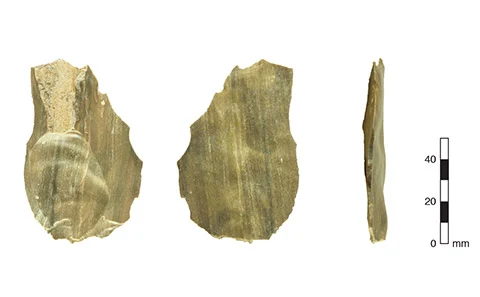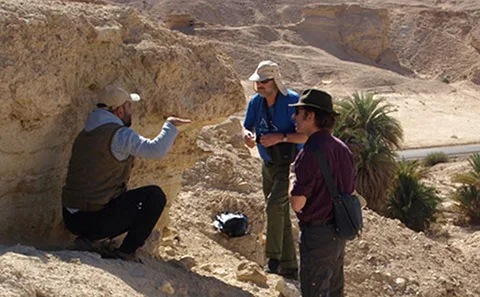Early Human Migrants Followed Lush Corridor-Route Out Of Africa | University of Southampton

There are several possible routes by which they could have migrated into Eurasia and from there into the rest of the world, and archaeologists have just reported finding just one such route up the East African coast, across the Sinai Peninsula, down the Red Sea coast of Arabia, through what is now Yemen and Oman and from there to Coastal South Asia.
An alternative route could have been to cross the narrow sea crossing at the southern end of the Red Sea, to southern Arabia and then go north to the Jordan Valley or along the southern coast of Arabia to Oman.
This conclusion comes from the fact that at that time, the Jordan Valley was a “well-watered corridor” which funneled hunter-gatherers through The Levant towards western Asia and northern Arabia via Jordan. Wandering tribes of hunter-gatherer have no particular destination in mind and would have migrated through where the environment provided food and water, so a watered corridor would naturally provide such a route.
This discovery was made by researchers from the University of Southampton (UK) and Shantou University (China), together with colleagues in Jordan, Australia and the Czech Republic. It is published open access in Science Advances and is explained in a press release from Southampton University:
An international team of scientists has found early human migrants left Africa for Eurasia, across the Sinai peninsula and on through Jordan, over 80-thousand years ago.The team's findings are published, open access in the journal Science Advances:
Researchers from the University of Southampton (UK) and Shantou University (China), together with colleagues in Jordan, Australia and the Czech Republic1, have proved there was a “well-watered corridor” which funneled hunter-gatherers through The Levant towards western Asia and northern Arabia via Jordan.
Their findings, published in the journal Science Advances, support previous research conducted in Arabia suggesting this green, overland route, which is now desert, was favoured by travelling Homo sapiens heading north.
‘Modern’ humans evolved in Africa between 300 and 200 thousand years ago and dispersed out of the continent in several stages. It’s thought that over tens of thousands of years they went on to populate Asia and then Europe.
For this latest research, the team conducted fieldwork in the Jordan Rift Valley where they uncovered hand tools, known as ‘flakes’, on the edge of wadis – now dry river channels which, tens of thousands of years ago, were full of water. The scientists used luminescence dating techniques to help establish the age of the sediment the tools were buried in. This method estimates how long it has been since sediment was last exposed to light.
The results showed the tools were likely to have been used approximately 84 thousand years ago and then abandoned on the banks of the wadis and subsequently buried over time.
It’s long been thought that when the sea level was low, humans used a southern crossing, via the Red Sea from the horn of Africa, to get to southwestern Arabia. However, our study confirms there was a well-trodden passage to the north, across the only land-route from Africa to Eurasia.
Our newly published evidence is a key piece of the puzzle that shows humans migrated using a northern route – using small wetland areas as bases whilst hunting abundant wildlife in the drier grasslands. Although previous studies have looked for large lakes as potential watering holes, in fact small wetlands were very important as staging posts during the migration.
Professor Paul Carling, co-author
Professor of Geomorphology
Geography & Environmental Sciences
University of Southampton, Southampton, UK.
The Levant acted as a well-watered corridor for modern humans to disperse out of Africa during the last interglacial, and we have now demonstrated this is the case in the Jordan Rift Valley zone.
The paleohydrological evidence from the Jordan desert enhances our understanding of the environmental setting at that time. Rather than dry desert, savannah grasslands would have provided the much-needed resources for humans to survive during their journey out of Africa and into southwest Asia and beyond.
Dr Mahmoud Abbas, lead author
Institute of Marine Sciences
Guangdong Provincial Key Laboratory of Marine Disaster Prediction and Prevention
Shantou University, Shantou, China.The researchers say their study demonstrates the intimate relationship between climate change, human survival and migrations.
AbstractNote that the fact of human origins in Africa is not in question, the debate is only over the route, and timing, of the various migrations out of Africa and into Eurasia. The evidence of climatology and archaeology converge with that of human genetics to show there was a corridor 80,000 years ago by which humans could have crossed the otherwise barriers of uninhabitable desert. Given the migratory nature of hunter-gatherer societies, migration along such corridors would have been inevitable.
Homo sapiens dispersed from Africa into Eurasia multiple times in the Middle and Late Pleistocene. The route, across northeastern Africa into the Levant, is a viable terrestrial corridor, as the present harsh southern Levant would probably have been savannahs and grasslands during the last interglaciation. Here, we document wetland sediments with luminescence ages falling in the last interglaciation in the southern Levant, showing protracted phases of moisture availability. Wetland sediments in Wadi Gharandal containing Levallois artifacts yielded an age of 84 ka. Our findings support the growing consensus for a well-watered Jordan Rift Valley that funneled migrants into western Asia and northern Arabia.
Abbas, Mahmoud; Lai, Zhongping; Jansen, John D.; Tu, Hua; Alqudah, Mohammad; Xu, Xiaolin; Al-Saqarat, Bety S.; Al Hseinat, Mu’ayyad; Ou, Xianjiao; Petraglia, Michael D.; Carling, Paul A.
Human dispersals out of Africa via the Levant
Science Advances; 9(40), eadi6838. DOI: 10.1126/sciadv.adi6838
Copyright: © 2023 The authors.
Published by American Association for the Advancement of Science. Open access.
Reprinted under a Creative Commons Attribution NonCommercial License 4.0 (CC BY-NC 4.0).
Just another example of real-world evidence refuting evidence-free creationist dogmas.




No comments :
Post a Comment
Obscene, threatening or obnoxious messages, preaching, abuse and spam will be removed, as will anything by known Internet trolls and stalkers, by known sock-puppet accounts and anything not connected with the post,
A claim made without evidence can be dismissed without evidence. Remember: your opinion is not an established fact unless corroborated.